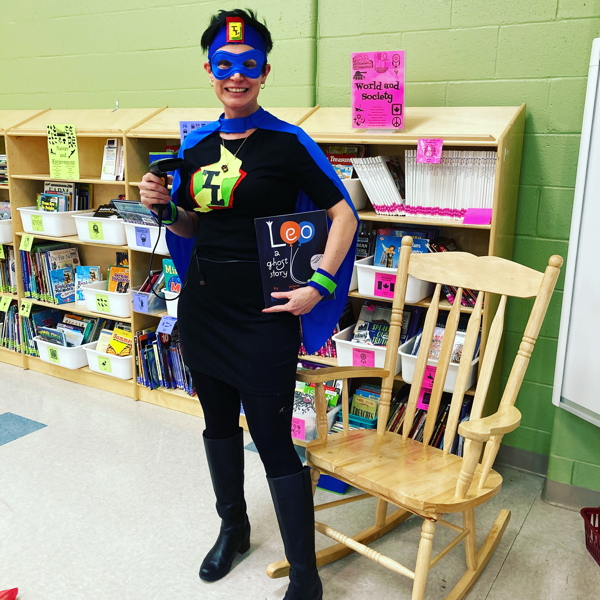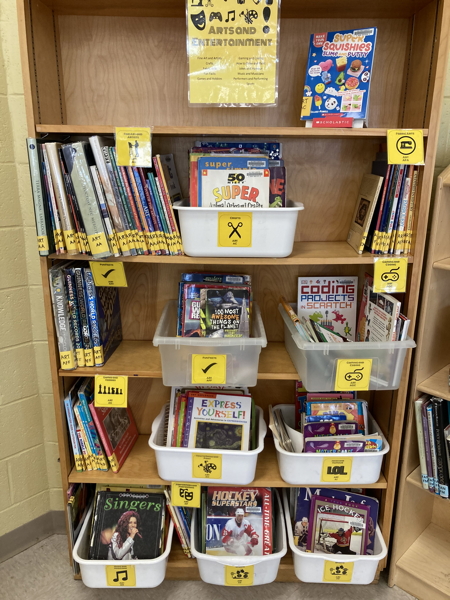
By Leigh Borden
Teacher-librarians across Newfoundland were happy to welcome students back into our schools and our school library learning commons in September 2020. Despite a challenging year to date with all schools in NL having been closed from March 17 through the end of the school year, schools reopened here in September with a goal of “…maximiz[ing] in-person attendance in the K-12 education system while ensuring health and safety measures to reduce the risk of COVID-19 transmission” (Newfoundland and Labrador K-12 Education Re-entry Plan, 2020). We have been fortunate in NL to have seen relatively few cases of COVID-19, allowing us a measure of freedom in our schools that is slightly greater than is being felt in other parts of the country. As we move forward in our ‘new normal,’ our school libraries are continuing to serve students, and indeed grow in new communities throughout the province.
As phase 3 of the Government of Newfoundland and Labrador’s Education Action Plan was rolled out this fall, additional teacher-librarian positions were created in many K-6 schools. These new teacher-librarians have been engaged in in-service training over the last month and are moving forward with building their own school library learning commons facilities in a variety of ways. It’s been important for us all to recognize that while there’s no cookie cutter solution or simple template for a quality school library learning commons, all students deserve access to an excellent program.

as fun as ever, despite the pandemic.
At our school library learning commons at Holy Trinity Elementary, a K-4 school of about 550 students located in a suburb of St. John’s, learning activities resumed within a week after reentry to school. While it has been necessary for us to limit the use of the SLLC to one class at a time for now (in order to keep cohorts intact), and to redirect some of our usual fall learning, our school library is as active and fun as ever!
A Day in the Life at our School Library Learning Commons
8 am: I arrive and spend the next hour sorting and re-shelving yesterday’s quarantined books. We quarantine items for 24 hours based on our Government’s protocol document. Oh, how I miss my volunteers, mainly parents who gave freely of their time each day to help in the administration of our library, so I could focus on teaching!
9 am: I check our library management system for book requests, pull them, and deliver them to classes. We use the Insignia LMS and students in grades 3 and 4 have learned to access our OPAC using their Google credentials to request items rather than visit the library for our usual 9-9:30 free-flow book exchange period.

9:30-noon: My classes arrive for storytime and book exchange. Students have learned to check in their own books, place them in quarantine, and sanitize their hands before storytime. After our storytime activity, students freely select new library books and check them out themselves (with grownup help as needed), sanitizing their hands again on the way out. Students stick to the “Book Zone” during this time, rather than the full library space. During a normal year, a second class would probably be sharing our library space during this time, working on inquiry or using technology, but shared use is on pause for now.
1-3: Classes visit their library for inquiry, research, STEAM activities, and more. During this time, we stick to the “Work Zone,” and follow our Safe Use of Technology rules in an effort to cut down on cross-contamination of spaces, furniture, etc. Between users, I clean our ChromeBooks using a two-step “wipe, then disinfect” process recommended by our School District. In STEAM activities, we are emphasizing the use of “you make it, you take it” consumable materials, or else a 24 hour quarantine period for other materials we might use.

As a result of my usual cadre of volunteers not being allowed in the building, it was necessary for me to reduce borrowing limits by half. But, on the positive side, the ‘Bookstore model’ reorganization of our non-fiction section that I undertook during the school closure last spring has resulted in a dramatically quicker re-shelving process—AND significantly increased circulation in that section. I am very sorry to have had to cancel our hugely popular free-flow book exchange each morning, but am pleased that students are utilizing more of the functions of our library OPAC. As well, I am sad not to be engaged in as many large-scale inquiry projects as I would normally be working on at this time of the school year, but am very happy to be focusing on building Google Apps for Education skills in all our learners, especially in case we should find our schools closed again at some time this year.
Our days may be different in 2020, but with the enthusiastic support of our colleagues and students, they continue to be full of important student learning here at our school library learning commons at Holy Trinity Elementary.

Leigh Borden is a K-4 teacher-librarian and President of Teacher Librarians of Newfoundland and Labrador. Over the past decade, she’s worked to advocate for school librarians and teacher-librarians across Newfoundland and Labrador, and has served on a variety of committees and working groups intended to grow the school library learning commons movement in the province. Leigh completed a BA (Hons) at Memorial University of Newfoundland, an MA in English literature at the University of Toronto, and a Master of Teaching at OISE/UT. When not happily working in her school library, Leigh loves to read, run, hike, and camp.